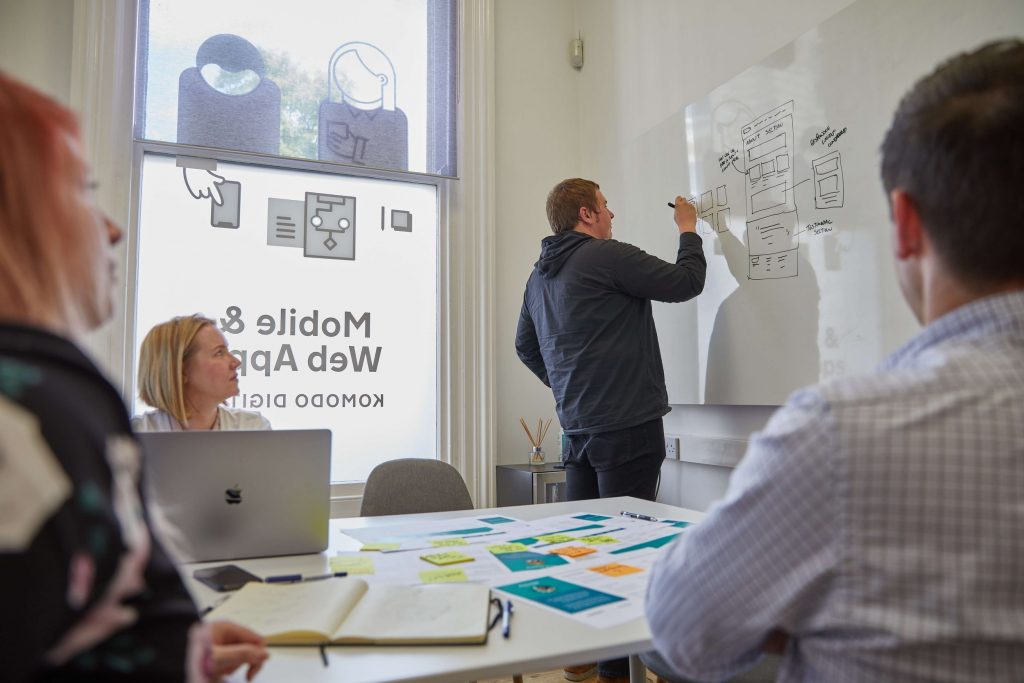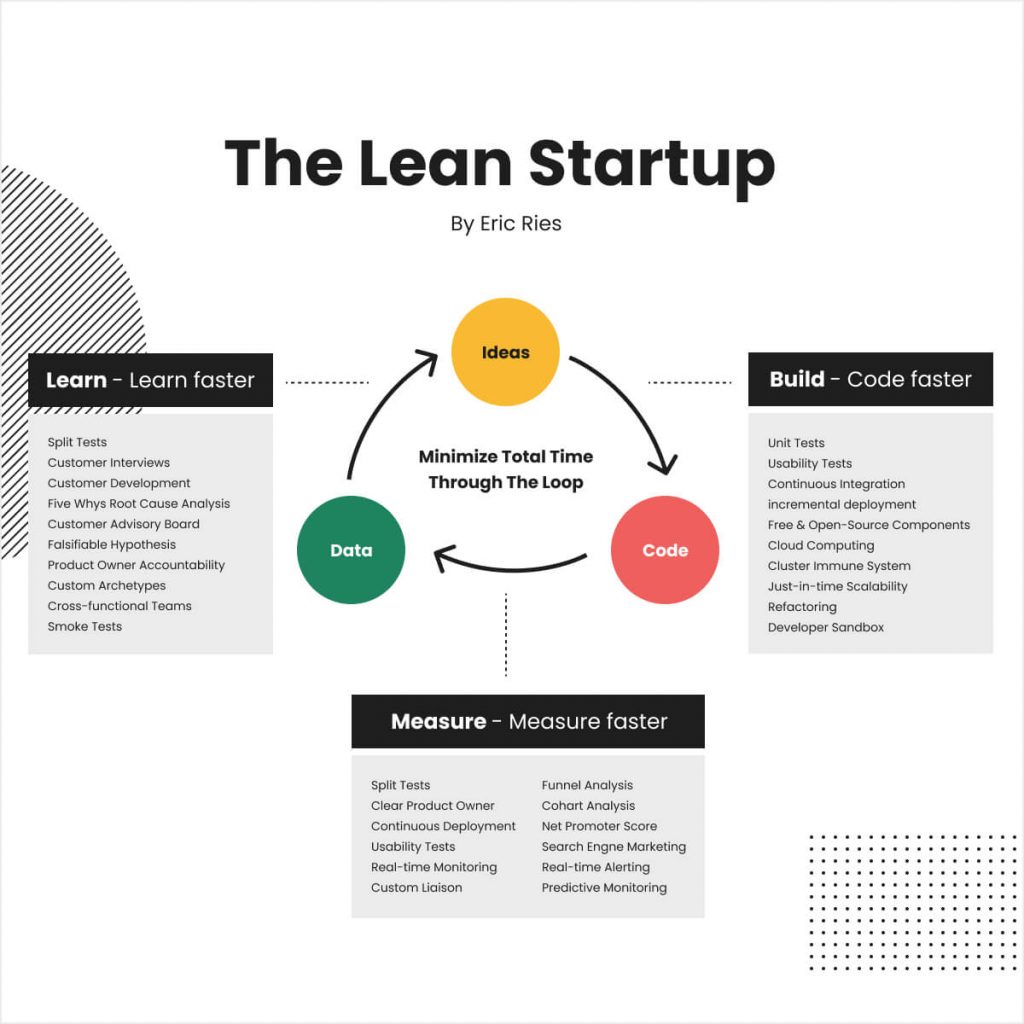How To Run a Lean Startup: What Does It Mean To Be ‘Lean’
Web Development
App Development

You’ve got an idea that’s going to take the world by storm. You’ve envisioned the tech, put together a pitch and even started assembling a team. But now you’re ready to get started and suddenly, you’re struggling with how to actually run your Startup.
In the fast-moving Startup world where most businesses fail from the beginning, one form of project management has risen to the forefront. This system is all about the Startup mentality, capitalizing on the idea of moving quickly and insulating yourself against failure.
It’s also something we, as a creative digital product studio, are familiar with. After all, this project management methodology comes from the world of manufacturing but has been widely adopted by technology teams who have driven incredible change in their own organisations and the world at large.
We’re talking, of course, about the “Lean methodology”.
What is the Lean methodology?
The term stems from lean manufacturing, a process that comes from automotive company Toyota and their Toyota Production System - which was itself influenced by Henry Ford and his assembly line system. This was a ‘Just in time’ system that only began production when an item was needed, cutting down on waste.
In their book ‘The Machine That Changed The World’, James P. Womack, Daniel T. Jones and Daniel Roos took the Toyota system and established a set of guiding principles for Lean methodology that could be applied to more than just automotive design.
Define value: what is your customer willing to pay for, or what is it that they need? What value can you offer them? You can incorporate user research techniques such as interviews into this process to ensure you get the right input.
Map value stream: match your customer’s needs with the activities that add value to these needs. Those that don’t should be discarded as waste.
Create flow: when waste is removed, reassess your product against customer needs and ensure a smooth flow without delays or interruptions.
Establish pull: create a ‘just in time’ system where output/products are created as a result of need, removing the chance of waste occurring through redundant time on an unnecessary product.
Pursue perfection: establish a culture of continuous improvement.

Lean is all about continuous improvement - cutting out waste and improving your product DURING its production. Lean is similar to Agile, another popular methodology in software development, but differs in that it is not focused on short sprints and instead works on continual improvement and reducing waste.
How Lean impacts software development
It’s fairly easy to see how Lean, a methodology that originated in mechanical production, can be applied to digital products. For most of the guiding principles, software-specific elements come into play. For example:
Define value: use research, data and analytics to assess customer needs. Unlike traditional marketing, you have access to digital behaviours that can help prove a need for your product.
Map value stream: features and functionality should be created to help users accomplish their needs. Any excess functions/features are ‘waste’ and can be discarded or reduced.
Create flow: use UX design principles to establish a smooth interface between customers and software. Cut out unnecessary steps.
Establish pull: plan new features and updates by allowing users to submit feedback, requests and other customer-driven demand.
Pursue perfection: use iterative development to update and improve your software continually. Ensure all teams have this mentality and want to make the product the best it can be.
Lean vs Agile

Lean software development is arguably more of a mindset than it is a process. Compared to Agile, Lean is more of a set of guidelines than a system of working. Agile is instead a system that breaks development team output into ‘sprints’ focused on releasing certain features. It was created out of a need to give developers a way to work on products in an iterative fashion that avoided an over-commitment in time and a redundant launch where a product was outdated before it even got to market.
Thanks to the Agile Manifesto and a dedicated following, Agile has become a more rigidly defined system that can be implemented by incorporating defined roles, structured meetings, estimation techniques, systematic reviews, and sprint cycles. Lean is more of a ‘way of thinking’ that aims to get an entire organisation on the same page when it comes to minimising waste and improving end-result.
Though both Lean and Agile share some similarities, they have unique approaches:
Both methods prioritise speed of delivery - with Agile focusing on small batch sizes in sprints, whereas Lean would aim to speed up flow by minimising the amount of work-in-process.
Putting the customer first is always a consideration for both methodologies - with Agile using lots of customer feedback throughout sprints to stay reactive and Lean instead looking at cutting out waste (remember that waste means whatever a customer doesn’t need/want).
Both aim to streamline workflow. Agile does this through its documented system and sprint-based working cycles. Lean is instead about an overhaul of how a company thinks of its processes - too much work in progress, task-switching and manual work if automated alternatives exist would all be classed as waste in a Lean organisation.
However, where Agile may be the better ‘system’ for software development teams who need a refined, robust way of managing a project, Lean as a methodology is arguably the easier system to introduce to a business - especially startups who have not yet established their way of working or corporate culture.
What is the Lean startup approach?
Lean startups combine Lean methodology with startup culture. The term was coined in 2011 by Eric Ries in his book, The Lean Startup. They are a new generation of startup businesses that exist mainly as a result of the massive rate of failure for new businesses. In a world where 75%+ of startups fail in their first year, Lean principles have given startups a whole new way to work.
Traditionally, a startup would work on its product and hone it to completion before launching - then wonder why it failed to attract customers after nobody purchased it. Why did they fail?
Because they’d already committed heavy budgets and time to a product that was built solely on assumptions and guesswork. They did not have the proof that users would enjoy the product - or even that they wanted it.
The main difference between most startups and other businesses is that ‘startup’ generally applies solely to companies that launch something unique/untested. Other businesses such as a café or barber have a certain level of market confidence - they know people need to eat or get their hair cut. So many startups crash and burn because they do nothing about this gap of knowledge - they just assume their product will work and press on with it without user research.
As we’ve discussed in our articles about Minimum Viable Products (MVP), as well as in the User Research Workbook, you must understand your customer’s needs before you design a single aspect of your product.
Lean startups are inspired by Lean principles with their own unique approach. A lean startup has its idea for a product based on assumption and rather than spending months in research or even worse, development to create a full product, they will focus on producing an MVP, getting that MVP tested and then building out features based on user need.
Like we do here at KOMODO, this approach means you can cut down on the risk of failure, save time and money and create an app/software project that actually matters to customers.
So… What is the Lean Startup Methodology?
Now that we’ve assembled all the parts here, let’s put all of this together. Learn startups go through three key stages in their life cycle:
Problem/solution fit: validating the problem you’re solving with your startup - will customers pay for it? (See Lean methodology principle ‘Define value’)
Product/market fit: validate your MVP by launching it to customers and assessing its performance in the market. (Appreciate those early adopters!!)
Growth stage: once you have established need, you can begin to grow safely.
However, these growth stages are only possible through good practices at the beginning of a project. To establish them, lean startup methodology follows a set of guiding principles that are unique to the startup world but still share principles with traditional lean ideas. In many ways, the principles are even more simple than general Lean - though each step should be prefaced by an ‘idea’ phase.
And it up the three steps can be roughly summarised by three steps:
Build: from the initial idea, build an MVP and get it to customers.
Measure: assess the user feedback and gather suggestions.
Learn: use the insights and data to iterate.
 The infographic above pairs speedy strategies and processes with the Lean Startup methodology. As in traditional Lean methodology, Lean Startup thinking is all about eliminating waste and prioritising customer needs. By removing the risk of front-loading your development time, you can build a business based on genuine user requirements, proven through testing. Like the ‘Just in time’ system developed by Toyota many years ago, your Startup’s product will adapt to offer what users want, cut out what they don’t and allow for growth based on a real, tangible need. At KOMODO, we have incorporated Lean methodology and thinking into everything we do. We’ve been championing the concept of MVP launches and cutting down on development waste for years - and we love working with startups who want to adopt similar ways of thinking and launch more effective products.
The infographic above pairs speedy strategies and processes with the Lean Startup methodology. As in traditional Lean methodology, Lean Startup thinking is all about eliminating waste and prioritising customer needs. By removing the risk of front-loading your development time, you can build a business based on genuine user requirements, proven through testing. Like the ‘Just in time’ system developed by Toyota many years ago, your Startup’s product will adapt to offer what users want, cut out what they don’t and allow for growth based on a real, tangible need. At KOMODO, we have incorporated Lean methodology and thinking into everything we do. We’ve been championing the concept of MVP launches and cutting down on development waste for years - and we love working with startups who want to adopt similar ways of thinking and launch more effective products.

Got an idea? Let us know.
Discover how Komodo Digital can turn your concept into reality. Contact us today to explore the possibilities and unleash the potential of your idea.

Sign up to our newsletter
Be the first to hear about our events, industry insights and what’s going on at Komodo. We promise we’ll respect your inbox and only send you stuff we’d actually read ourselves.






